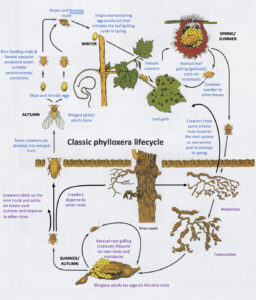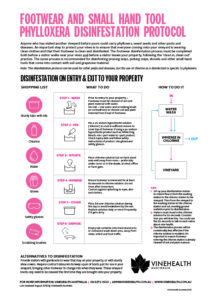Grape phylloxera (Daktulosphaira vitifoliae) is one of the greatest biosecurity threats to vineyards in South Australia. This tiny insect pest destroys grapevines by feeding on their roots.
Almost 75% of vines in South Australia are susceptible to attack. Once vines are infested, they will die within six years.
There is no eradicative treatment, so infested vineyards must be replanted on phylloxera-tolerant rootstock. This is a costly exercise at around $60,000/hectare (calculated in 2017 by Vinehealth Australia and benchmarked against industry standards), and replanted vines will take about three years to produce a crop and longer to mature.
For more information on phylloxera lifecycle, how it spreads, signs of infestation in the vineyard and more, click on the ‘About Grape Phylloxera’ fact sheet.
If you suspect that your vineyard has phylloxera, you are legally obliged to report it to your state biosecurity department, or in South Australia, you can contact Vinehealth Australia on (08) 8273 0550.
Where is phylloxera in Australia?
Phylloxera, at present, is confined to regions in Victoria and New South Wales.
South Australia, Western Australia, Northern Territory and Tasmania are designated ‘phylloxera-free’.
For policy, regulatory and management purposes, our wine regions are classified into Phylloxera Management Zones according to evidence of phylloxera presence, absence or unknown (untested) status:
- Phylloxera Exclusion Zones (PEZ) – a whole state or part thereof, recognised to be free of phylloxera.
- Phylloxera Risk Zones (PRZ) – an area of unknown phylloxera status (but never detected).
- Phylloxera Infested Zones (PIZ) – an area known to have phylloxera.
Movement of items (e.g. machinery, equipment, grapes, grape products, propagation material, diagnostic samples and soil) that could potentially transfer phylloxera from one place to another are tightly controlled between these areas).
To confirm the Phylloxera Management Zone (PMZ) your vineyard is in, either refer to the Phylloxera Management Zones in Australia map or use our interactive maps tool to choose your wine region and find out which PMZ it’s in.
Phylloxera strains
Not all grape phylloxera are equal. There have been several hundred genetic strains of phylloxera documented worldwide, with Australia identifying 115 endemic strains. Click here for more information on strains.
Phylloxera lifecycle
The phylloxera lifecycle involves egg, nymph and adult stages. Adult phylloxera are 1mm long, yellow to brown in colour and predominantly reproduce asexually in Australia.
Adults can lay around 200 eggs per cycle and are capable of several breeding cycles per season, depending on the virulence of the phylloxera strain, nutrition and environmental conditions. Populations peak between November and March.
Click on the image for a larger version.
Rootstocks
Planting to phylloxera tolerant rootstocks is an important preventative measure.
Phylloxera tolerant rootstocks are bred from grapevines native to North America known as American vitis species. These species evolved in the presence of the phylloxera and so developed tolerance mechanisms that allowed them to continue to flourish in the presence of the insect.
Wine Australia’s Rootstock Selector tool can assist you in your rootstock choices.
Farm-gate hygiene practices
There are a number of simple activities you can carry out to reduce the likelihood of phylloxera being introduced into your vineyard. Refer to our Tools section for detailed information.
Phylloxera: hard to kill
Much time and effort has been invested over the years by Agriculture Victoria research staff trying to find effective footbath solutions to kill grape phylloxera. Coca cola, Epsom salts, coffee, cayenne pepper, vinegar and mineral turpentine have all been trialed.
These studies have determined that there are five vital aspects to ensuring efficacy of the footbath:
- The active ingredient
- The concentration of the active ingredient
- The surface of the item to be disinfested is clean of soil and plant material prior to the disinfestation treatment
- The duration of the disinfestation
- Ensuring no water rinse is undertaken after the disinfestation
Through scientific studies, there are still only a handful of active ingredients that have demonstrated efficacy against a range of phylloxera strains. These are:
OPTION 1: BLEACH DILUTED
- Active ingredient of 40g/L (minimum) of sodium hypochlorite
- This active is sold commercially as bleach under various brand names including White King, Premium Bleach
- Dilution: use in the same volume to water (as 1:1 dilution)
- Disinfestation time: 60 seconds
- Pack size: up to 2.5L
OPTION 2: BLEACH UNDILUTED
- Active ingredient of 40g/L (minimum) of sodium hypochlorite
- Dilution: use undiluted
- Disinfestation time: 30 seconds
- Pack size: up to 2.5L
OPTION 3: METHS
- Active ingredient of 95% ethyl alcohol
- This active is sold commercially as methylated spirits
- Dilution: use undiluted
- Disinfestation time: 30 seconds
- Caution: flammable
- Pack size: up to 20L
OPTION 4: DETTOL
- Active ingredient of 4.8% chloroxylenol
- This active is sold commercially as Dettol antiseptic
- Dilution: use undiluted
- Disinfestation time: 60 seconds
- Caution: flammable
- Pack size: up to 2L (note we have contacted the manufacturer to query availability of larger pack sizes, but to no avail)
Footwear disinfestation
Phylloxera is very difficult to kill and only very few active ingredients have been proven effective against this pest. Disinfestation using bleach has been proven effective to kill phylloxera.
Use our Footwear and Small Hand Tool Disinfestation Protocol which is based on the latest peer-reviewed science and includes 40g/L sodium hypochlorite (bleach) or undiluted 4.8% chloroxylenol (Dettol) as the disinfectant for a 60 second immersion without a water rinse thereafter.
Our Footwear and Small Hand Tool Disinfestation Protocol poster is one of our most popular resources. In response to industry requests, we’ve had this poster translated into common vineyard worker languages – Dari, Hindi, Khmer, Pashto and Vietnamese.
Articles
Additional information can be found in a range of articles in our ‘Featured articles‘ section under the headings of ‘Pest and Disease’, ‘Farm-gate hygiene’ and ‘Rootstocks’.


